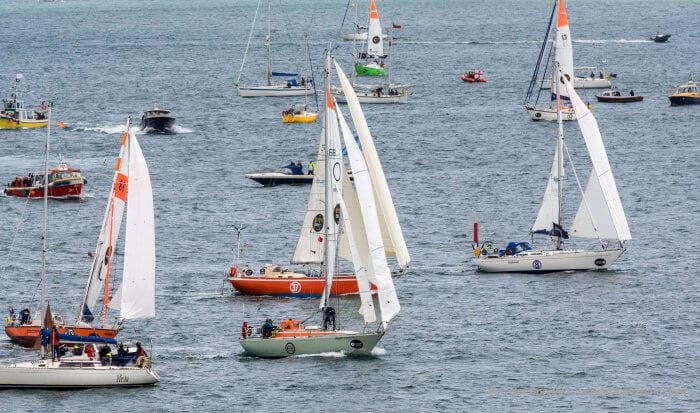
Looking out at the little fleet gathered at Falmouth’s Yacht Haven, it seemed an awful long time since I attended the Race Entrants Conference in London back in 2015.
Since then there has been much water under the bridge and the Golden Globe Race (GGR) has seen many changes, from the start and finish venue to the entrants list, so I’m sure that all concerned were glad to hear the starting cannon as the boats finally got under way.
Albeit that this was only the feeder race down to the ‘new’ official start venue of Les Sables D’Olonne in west France, there were some interesting pointers as to how the main event might shape up.
And it was instructive to view this fleet of older designs and see how the teams have prepared the boats for such an arduous race, taking in as it does the vast wastes of the Southern Ocean.
How Does The Fleet Shape Up?
At the time of the 2015 Conference the entry list (maximum 30 boats) was almost full and there was already a waiting list for the last few places available. Since then there has been a considerable reduction in the entry list and 17 of the entered boats crossed the line off Pendennis Point to head for the official race start at Les Sables, with one boat being transported there by truck as she was still not ready at the time of the feeder race.
Of course, there may be many reasons for this rate of attrition: cost (see my previous post), injury (in the case of ‘my’ entrant Fabrizio Ladi Bucciolini), and I’ve no doubt some of the would-be entrants drew a long, sharp breath after the abandonment of the Tradewind 35 Mushka on the way to the race.
This is a race that has the potential to bite back and this was a stark reminder of that fact.
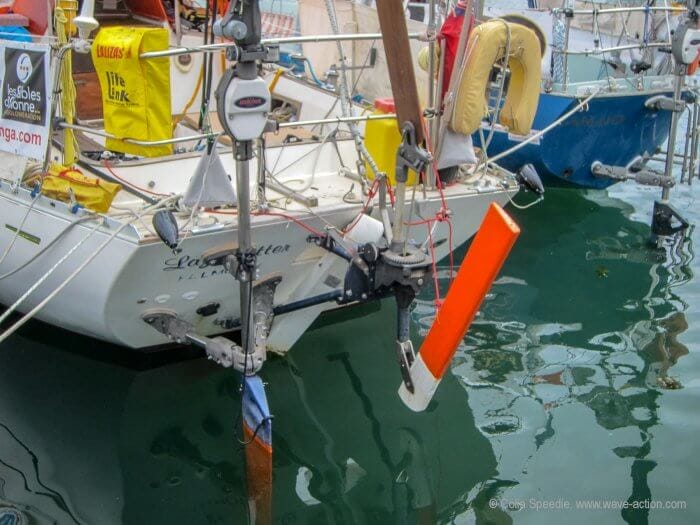
There was plenty of evidence, though, that this message has got through loud and clear, looking at the well-prepared fleet on display at the Falmouth Yacht Haven.
Autopilots are out in this most ‘retro’ of races, so windvanes of every persuasion were on display on all of the yachts.
Many had sensibly opted to construct hard dodgers with reinforced companionway hatches, and one entrant had even done away with the coachroof windows altogether!

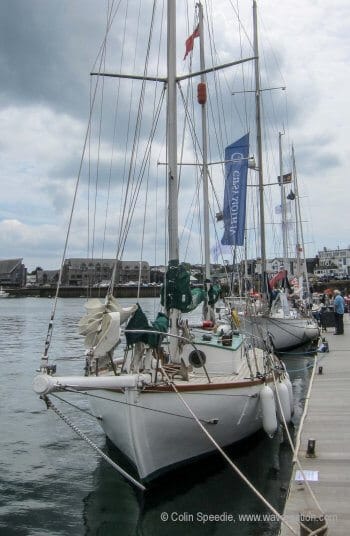
It was interesting to see the boat that started the whole single-handed ball game off, Suhaili alongside with the modern fleet.
Sir Robin Knox-Johnson had sailed her down to start the feeder race, fifty years after his successful return as the only finisher (and therefore winner) of the inaugural Golden Globe Race, and he was on hand throughout, dispensing good cheer and great anecdotes.
Suhaili is little changed from her original trim, still looking tough and purposeful and ready to go again, if required.
Just down the dock from her was Abhilash Tomy’s Thuriya, a modern take on Suhaili, also built in India like her sister, but this time in lightweight wood/epoxy as opposed to heavy teak construction. Very nicely finished and looking totally ready to go, it will be fascinating to see how she performs.

Nearly a third of the fleet are Rustler 36s, chosen by several of the more fancied entrants, such as Jean-Luc Van Den Heede (Matmut), Susie Goodall (DHL Starlight), Phillippe Peche (PRB) and Mark Slats (Ohpen Maverick). These boats are perhaps the closest to what might be termed a cruiser-racer and quite a lot of them were built, so maybe that’s unsurprising.
Real heavy displacement boats like the Endurance 35 (3) and the Tradewind 35 (2) were also well represented by such experienced skippers as Istvan Kopar (Puffin) and should face up to the rough stuff well, as should the three Falmouth-built Biscay 36 ketches, with Antoine Cousot’s smart green example Metier Interim looking particularly well fettled.
The remainder of the fleet fell somewhere between the two extremes, which may prove a sensible choice: a good blend of heavy weather ability and light airs speed. Mark Sinclair’s Lello 34 Coconut made a good start to show what these boats can do.
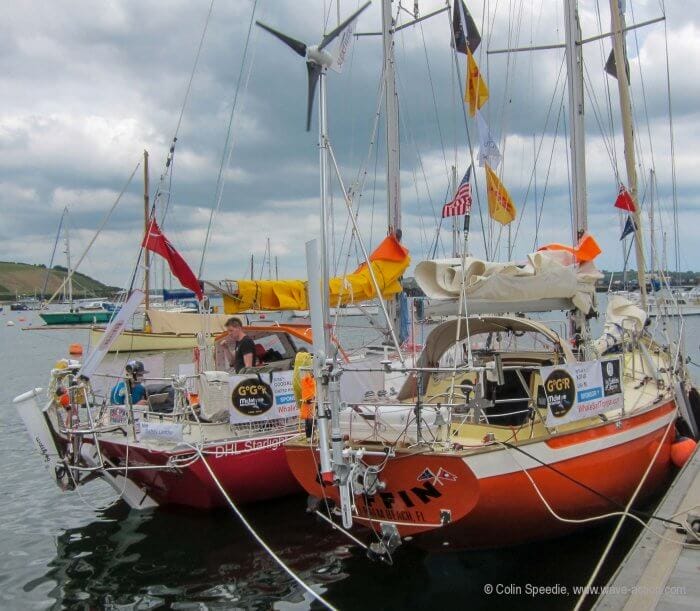
On Their Way
Sir Robin on Suhaili fired the starting cannon and the fleet got away to an offwind start down towards the Lizard and out into the Channel.
Mark Slats, just back from winning and breaking the singlehanded class record in a Transatlantic rowing race, was first away, followed by Jean-Luc Van Den Heede.
Are Wiig was the only one brave enough to get the spinnaker up and went charging away, although there were a few hairy moments in the fresh breeze when that looked like it might not have been the brightest idea of the day.
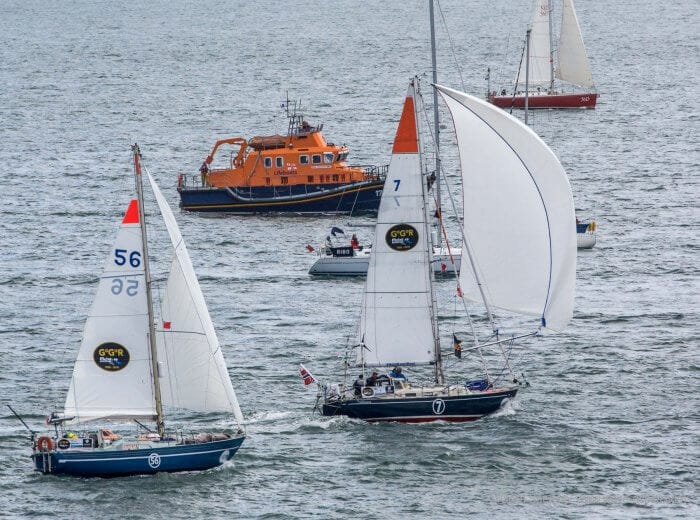
The yachts are all equipped with a transponder system that can only be seen by the likes of us racing vicariously at our screens—the individual competitors can’t see this, so can’t keep track of each other.
The fleet spread out as they approached the French coast and had to make the call whether they were in time to catch the tide down through the Raz de Sein or not—one of those tidal gates that can make your day or break your heart. Get it right and you are on a magic carpet ride; get it wrong and you’ll be parked for hours looking at the Phare Eckmuhl on the Pointe de Penmarc’h.
Mark Slats and Jean-Luc Van Den Heede were first through, which put them in good shape for the run down the French coast, whilst others too late to make the gate took the long route outside the Ile de Sein.
At the finish it was these two first home with Istvan Kopar in third position. Phillippe Peche and Susie Goodall were both well up, too, so the Rustlers look like a good bet so far, although I wouldn’t read too much into it as this was only a short coastal dash with extra crew on board for this feeder race only.
You don’t have to be mad to work here, but….
Lou and I enjoyed an excellent evening with the skippers down at the Royal Cornwall Yacht Club the night before the race start. There was none of the testosterone-driven chest beating on display that puts many people off yacht racing (and yacht racers), which was a welcome change, so mingling with the skippers (from 13 countries) was a great pleasure.
None of them seemed remotely mad, which was reassuring, in tune with the ever-ebullient Sir Robin, who, when examined by a psychiatrist before his departure from Falmouth fifty years ago was declared “distressingly normal”. And maybe that’s what they need to be. This will be a really tough event.
As I write this, the fleet are well on their way, having left Les Sables D’Olonne on July 1st, with the leaders down towards Cape St Vincent. The lead has changed several times between Philippe Peche, Jean-Luc Van Den Heede and Mark Slats, with Uku Randmaa and Susie Goodall chasing hard—all in Rustler 36s. At this stage it’s looking like a split fleet of racers versus cruisers but, as Suhaili proved in the original race, anything can happen.
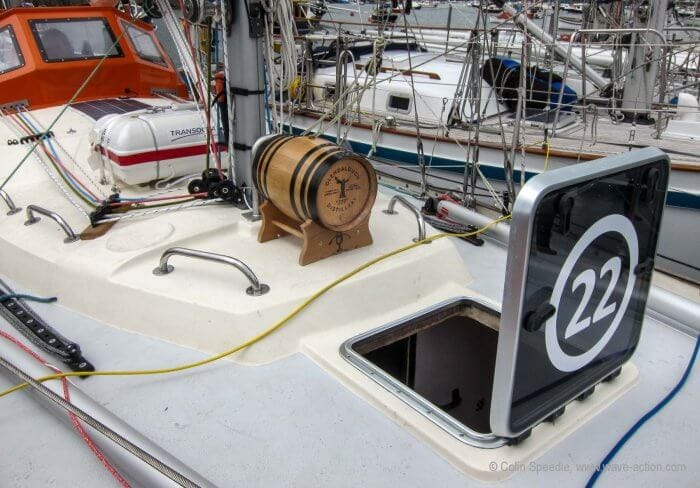

A good write-up, Colin. There was some discussion on a Facebook SSB group I’m in and one of the members wanted to communicate with Slats via SSB, but the frequency she was told he monitered was for Morse code (CW) only…I am a bit confused as to how many elements of offshore cruising are meant to be late-’60s grade in this race versus 2018, as I have to think each boat has (in addition to the tracking) modern DSC VHF, EPIRBs, modern synthetic running rigging, possibly AIS and certainly LED lights and other mod cons.
Also, I’ve met Sir Robin. “Distressingly normal”, sure, but pretty intense, too.
Hi Marc
yes, the boats have a lot of modern equipment as safety features, the limitation is in how they are permitted to use it! For the most part I think that the rules are sensible, and no fancy aramid fibres etc are permitted to bump up cost and change the face ofd the race entirely.
I’ve met Sir Robin a couple to times and find him inspirational – but there’s no doubt he’s a real competitor and that may explain the intensity.
Best wishes
Colin
Hi Colin,
Nice report,
For one who largely does not follow sports including yacht racing, it is nice to have a report that makes sense of the proceedings. Too often I am lost by a yachting article on a race when it refers to an event’s history or a requirement or something that I am unfamiliar with that makes portions of the article bewildering. This is shaping up to be fun. Thank you for bringing me along.
My best, Dick Stevenson, s/v Alchemy
Hi Dick
I’m no sports fan either! But I did quite a bit of yacht racing over the years and admire how much it can teach you about getting the best out of a boat.
And so I’m not much exercised who wins this race, any more than I am another. What I am interested in is the human element, the boats and their gear and the sheer challenge of facing the Souther Ocean in such small boats.
Which are actually there sort of boats many of our readers own our aspire to and as you know only too well, we all face our own personal Southern Ocean at times when we head offshore. I’m sure there will be lessons we can all learn from the experiences of these brave people and their simple boats – which is what I hope to be a conduit for.
Glad you’re along for the ride!
Best wishes
Colin
This was a great read, thanks.
The race is really well set up for online following, which was a surprise to me. Maybe I shouldn’t have been surprised, as Don McIntyre is a canny one. Following the boats with the YB Races app is great; the GGR Facebook page is updated super regularly with long and often fascinating videos; we can listen to the weekly check-in ‘phone’ calls from all the skippers with Don and follow the daily-ish text updates from all the skippers on Twitter or on the GGR Facebook page. I’m loving everything about it…so much so that I’m dreaming of doing it myself in 2022! But for now: GO SUSIE!
Another thing that’s happening right now is the Longue Route 2018 (http://www.longueroute2018.com), another round the world in memory of (my hero) Bernard Moitessier’s famous voyage. This isn’t a race of course and there are no rules, and there is an amazing range of boats. You can also track the skippers on the website. Its’s all rather more philosophical and esoteric, as you would imagine from those following in the wake of Moitessier 🙂
I’m pretty obsessed with both of these events and it’s fascinating to watch them side by side.
Fair winds!
Justine (S&S 34 ‘Kite’)
Hi Justine
yes, the GGR has a good website and it’s possible to keep up to date with the race easily. I think they’ve done a creditable job in making the race accessible and ‘up to date’ without giving us the day-to-day minutiae of some of the big events that I’m afraid leaves me cold.
Thanks for giving us the heads-up on the Longue Route – I’ll be checking it out.
Ah, Bernard – what a character. I loved the Long Route, like so many of my generation and recommended it to many who also enjoyed it. His book sent so many off to sea in a ‘vagabondish’ way, which obviously still resonates among the more romantic amongst us.
And yes – GO SUSIE!
Best wishes
Colin
Colin
As one would expect, the participants in the Longue Route are very different to those in the GGR, being for the most part unsponsored, low-profile and little interested in publicity. I would not expect to hear anything from the majority between them departing from Europe and returning, for whatever reason, to land. Certainly that is true of the two that I know personally, Tony Curphey and Susanne Huber-Curphey.
Tony sails a 1970’s Nicholson 35 of no particular distinction other than it was very cheap and he was very poor. Susanne a very nice aluminium vessel, largely built by her. They are married but sail independently, crossing paths at irregular intervals. To get to Europe for this voyage, Susanne sailed single handed from New Zealand by way of the North West Passage. I believe Tony took the more conventional route by way of Cape Horn. In most circles either passage would be regarded as exceptional, but there was little publicity of Susanne’s voyage and none at all of Tony’s, which is how they would wish it.
I last saw Tony in Fremantle, Western Australia after he arrived without any fuss or publicity direct from the Canaries in a very creditable time – 109 days if my memory serves. Having visited some relatives in Perth (his reason for going there) Tony set off towards New Zealand. I was going in another direction and have not seen him since. His comms then and probably now consisted of a VHF. I believe Susanne’s set up is a bit more sophisticated, but would not expect to hear of either while they are at sea.
Cheers
Trevor
Hi Trevor
very much in tune with Bernard Moitessier indeed!
It’s always good to hear about those sailors who simply quietly get on with some amazing, inspirational passages, even though I think they’d be surprised to hear them described as such.
And on budgets to match, too, proof indeed that you don’t need to send a fortune to make good passages to wonderful regions. One of the things that I noticed during my involvement with the GGR was the way that the boats largely ended up being anything but cheap.
Good to know that there’s still a wide spectrum of people out there, above all.
Best wishes
Colin
Hi Trevor,
Thanks for an excellent introduction to a fascinating couple. We met Susanne some 10 years ago at a function when she was receiving seamanship award for towing Tony for hundreds of miles to port after his rudder failed.
We have kept in touch sporadically since and then she was in Lunenburg over last winter after her Northwest Passage transit.
We had her to dinner and had a fascinating and fun evening. By the way, despite having pulled off her singlehanded NWP transit in very fine form, and being ready to winter over if required, she, without prompting, allowed as how you and I were right, said transit was neither fun nor a good idea!